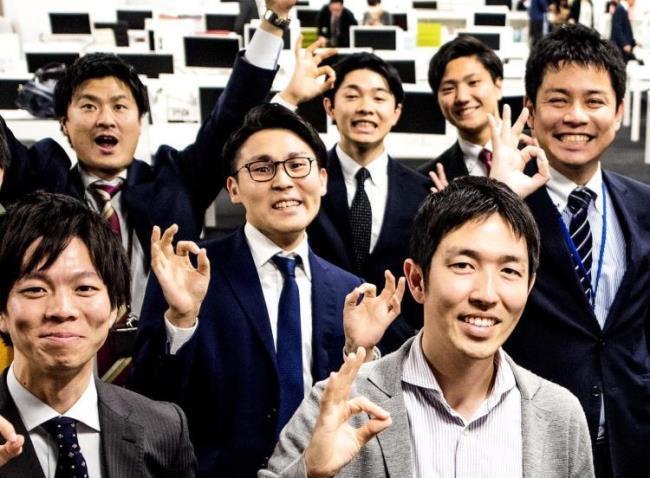
Kosuke Fujishima makes the sign for ‘astrobiology' – as imagined by one of the members of the FirstLogic audience – after his talk. (Nerissa Escanlar)
ELSI scientists often give talks to scientific groups and sometimes to the general public. But there has never been an ELSI lecture quite like the one featuring associate professor Kosuke Fujishima before an audience of young businessmen and women at the real estate investment firm, FirstLogic, Inc.
The well-attended and well-received talk marked the beginning of a formal relationship between Fujishima, ELSI and FirstLogic. In an act of unconventional philanthropy, the owner of FirstLogic had agreed to support Fujishima for two years at ELSI as he researches the role of peptides in the origins of life, and reaches out to students and the public to introduce them to the origins story.
‘Astrobiology, in my opinion, is the science directly linked to the future of humanity and the excitement and fundamental curiosity that we all have but disappear as we grow up’, said Fujishima, who previously worked at the NASA Ames Research Center as an ELSI Origins Network fellow.
‘Although it is difficult to have monetary value or to be implemented immediately in society, there sure will be a long-term effect if we can make a positive impact on human beings and their perception.’
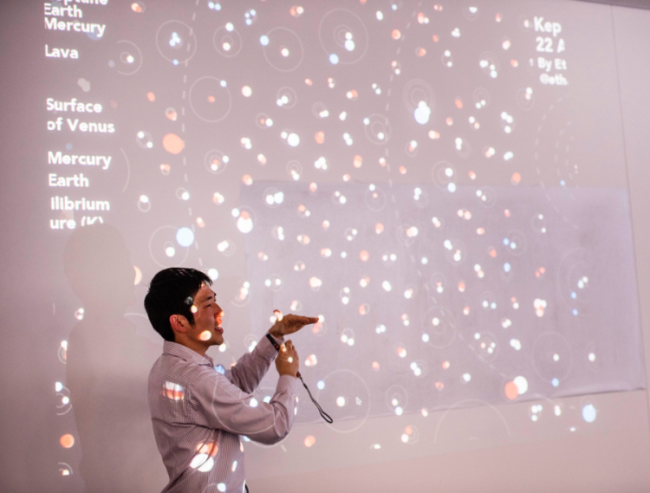
Fujishima is a specially appointed associate professor at ELSI. (Nerissa Escanlar)
The founder of FirstLogic is Naohiro Sakaguchi, an entrepreneur who has had a longstanding interest in how and why life began on Earth – one that he says began in his early youth and, ironically, with the death of his grandfather.
He wondered why we are born if we’re only going to die, and over the years he turned to philosophy, psychology and literature to seek answers. Unsatisfied, he ultimately turned to science to throw light on some of his questions and concerns, and especially to origins of life science.
His company had grown substantially in the fourteen years since Sakaguchi founded it, and FirstLogic had become a publicly traded enterprise with dozens of employees. So his life-long desire to have some of those paramount human mysteries addressed is today coupled with an ability to financially help support the work.
It took several years to select the institute and scientist that seemed right to him, he said, and Fujishima and ELSI met his most important criteria.
‘The critical point was that the research was done as an organisation’, Sakaguchi said. ‘Many other universities and research institutes were conducting studies as an individual researcher or professor, and I felt that they would not last too long.’
‘On the other hand, people from different fields were conducting research together as an organisation at ELSI, which I felt was the most efficient. I also thought that it would be better to make a donation to the area that had funding difficulties rather than a well-funded one. In that case, I wanted to fund researchers of the origins of life.’
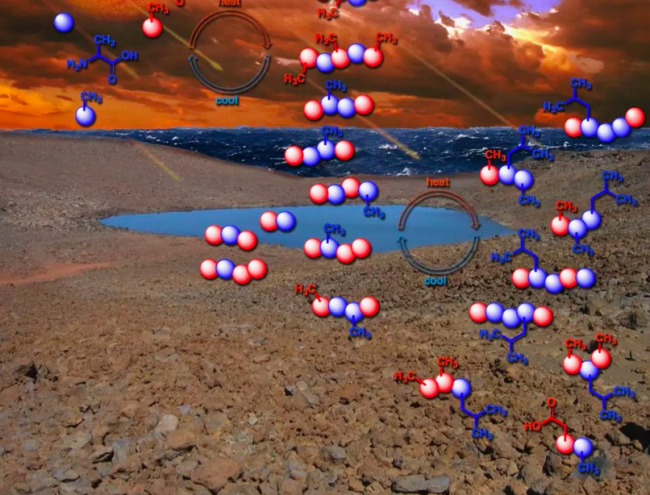
Researchers have found that drying out and rewetting the geochemical molecules could help form longer and more advanced peptides. (Ram Krishnamurthy/Center for Chemical Evolution)
ELSI, of course, has scores of origins of life researchers from all disciplines and approaches to science. Fujishima now studies peptides – short chains of amino acids (building blocks of life) that may well have played a critical role in the transition to geochemistry to biochemistry on early Earth. In other words, he is researching on a molecular basis a crucial component of the origins of life.
One of his main lines of research involves experiments that look at whether (and how) sequences of simple peptides can be ‘selected’ on mineral surfaces.
On early Earth these peptides may have contained many amino acids that are not now part of the set of 20 amino acids that are used by biology. So the question of how biology came to use only those particular 20 amino acids to construct the essential polymers responsible for structure and catalysis is a central one.
‘What I’m finding is that the mineral is selecting peptides. It’s not copying (like with DNA or RNA) but filtering some sequences from the original random pool. We think this is one of the first key steps in how meaningful molecules will accumulate in various environmental settings, which then allows a transition from pure geochemical reaction to organo-metallic biochemistry. That being said, the environment is acting as the original filter.’
Fujishima is also involved in efforts to better understand the plumes of vapour that gush out of Saturn’s moon Enceladus – geysers that some believe could harbour microscopic life from the oceans beneath the moon’s icy surface.
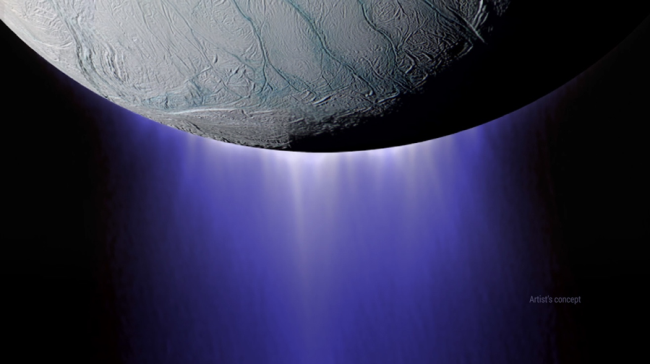
Vapour plumes coming out of the South Pole of the moon Enceladus. (NASA)
He said he is working with colleagues at the Japanese space agency JAXA about possible missions to Enceladus.
Fujishima is a researcher, but is also interested and involved in both public outreach and teaching.
Born in Japan but partially raised in London and then schooled at Keio University up until his doctorate, he also spent his postdoc days at NASA with astrobiologist Lynn Rothschild. So he is fluent in the languages and customs of Japan and the English-speaking West.
The two-year donation from FirstLogic will pay Fujishima’s salary as an ELSI researcher, and will also help pay for the summer-long study visit to ELSI of a University of California, Berkeley student majoring in molecular and cellular biology (but studying astrobiology at ELSI).
The expected outreach will include a series of origins lectures at ELSI’s host school, the Tokyo Institute of Technology, featuring Fujishima and five other ELSI researchers involved in early Earth chemistry and biology.
Fujishima’s kick-off talk was, not surprisingly, the one to employees of FirstLogic.
FirstLogic has been running seminars related to business and technology worlds, as might be expected at a company that provides information and insights to people drawn to the world of real estate investment.
When he started the company, Sakaguchi said, the real estate industry ‘was in terrible shape’ and his goal was to create a more fair real estate investment market.
‘We would like to make the market a place where even university students and homemakers can safely make real estate investments like the current stock market’, he said. ‘I hope that we can contribute to the development of society by making the real estate investment market fair.’
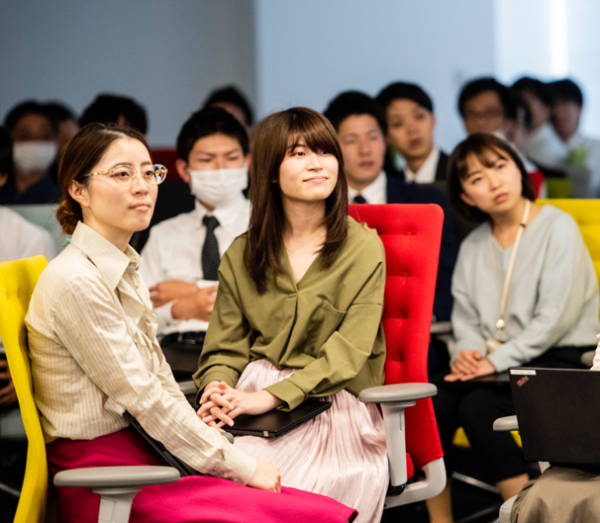
FirstLogic employees – IT engineers, sales representatives and managers – listen to Fujishima’s talk on astrobiology. (Nerissa Escanlar)
Given those company goals, a talk about the origins of life on Earth was unusual and, as Fujishima described it, had the audience initially not really knowing what was ahead. After all, he said, he was probably the first scientist to address the employees.
‘At first I was anxious whether topics related to astrobiology will be inspiring or fascinating for FirstLogic employees’, he said. But rather like their employer, Sakaguchi, they definitely warmed to the subject.
Fujishima began his talk by explaining how science worked and that its goal was to ‘seek the truth’ by understanding fundamental principles that help explain the workings of the world.
He then went on to describe the broad outlines of astrobiology – which includes the search for life beyond Earth and the study of how life might have originated on Earth and elsewhere – and then to the more specific logic of his own work.
Since he talked a lot about the origins of life, it was not surprising that someone from the audience asked ‘What is life?’
This provided an opportunity to explain that there is no firm definition, though there is some consensus about necessary attributes such as the presence of a chemical system that can gather energy from its surroundings, and can reproduce and evolve in a Darwinian fashion.

FirstLogic audience members. (Nerissa Escanlar)
Along the way, Fujishima introduced the creature known as the tardigrade, a rather bizarre microscopic marvel sometimes called a ‘water bear’.
These tiny invertebrate creatures can withstand extreme cold, extreme heat, enormous doses of radiation, and the far extremes of the alkalinity-acidic scale. They can go without water for years or decades because they enter a dormant state.
‘Their metabolism stops and they turn into objects, chunks of matter’, Fujishima explained. ‘They can stay that way for years and then come back to life when placed in water.’
One of the many messages of the tardigrade, he said, is that they show there is a real difference between ‘living’ and ‘life’.
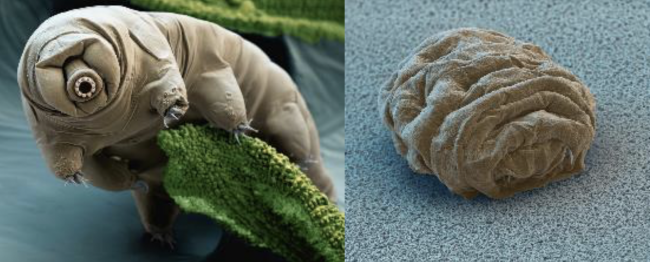
The tardigrade in its living and dormant state. © Eye of Science/Getty Images)
While ‘living’ is a continuous flow of active processes going on in an organism, ‘life’ is a system that can store information – in this case the architecture of the chemistry that allows a creature to live. That system is embedded in the tardigarde, even when for long periods it may not actually be ‘living’.
As Fujishima saw it, by the end of the talk much of the audience was clearly interested and the questions flowed. Properly presented, it seemed, research into the origins of life – and, more broadly, the scientific approach to the world – could engage a general public that had limited exposure to either.
Sakaguchi noted that, by engaging with astrobiology, it will encourage FirstLogic employees to keep out-of-box perspectives and think deeply with a long-term view while tackling their daily tasks.
It was the kind of challenging and unusual talk that Sakaguchi was no doubt hoping Fujishima would deliver.
------
Marc Kaufman has written books on astrobiology and Mars, has been a longtime reporter at The Washington Post and The Philadelphia Inquirer, and writes the NASA-supported online column Many Worlds (www.manyworlds.space) He has also had the good fortune to visit and work at ELSI numerous times and he wrote "ELSI RISING" -- the story of ELSI's origins and evolution -- in 2017.
